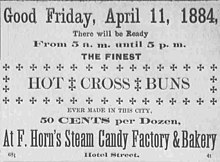- The Hot Cross Buns I became familiar with in church growing up had usually Vanilla icing on top in the shape of a cross. They were very good!
- begin quote from:
- Hot cross bun
Hot cross bun
Hot cross bun  Homemade hot cross buns
Homemade hot cross bunsType Spiced bun Place of origin United Kingdom Main ingredients currants or raisins A hot cross bun is a spiced sweet bun made with currants or raisins, marked with a cross on the top, and traditionally eaten on Good Friday in the British Isles, Australia, Canada, New Zealand, South Africa and some parts of the Americas. The cake marks the end of Lent and different parts of the hot cross bun have a certain meaning, including the cross representing the crucifixion of Jesus, and the spices inside signifying the spices used to embalm him at his burial.[1][2] They are now available all year round in some places.[3] Hot cross buns may go on sale in the United Kingdom, Australia and New Zealand as early as New Year's Day[4] or after Christmas.[5]History[edit]
In many historically Christian countries, plain buns made without dairy products (forbidden in Lent until Palm Sunday) are traditionally eaten hot or toasted during Lent, beginning with the evening of Shrove Tuesday (the evening before Ash Wednesday) to midday Good Friday.The ancient Greeks may have marked cakes with a cross.[6]One theory is that the Hot Cross Bun originates from St Albans, where Brother Thomas Rodcliffe, a 14th Century monk at St Albans Abbey, developed a similar recipe called an 'Alban Bun' and distributed the bun to the local poor on Good Friday, starting in 1361.[7]In the time of Elizabeth I of England (1592), the London Clerk of Markets issued a decree forbidding the sale of hot cross buns and other spiced breads, except at burials, on Good Friday, or at Christmas. The punishment for transgressing the decree was forfeiture of all the forbidden product to the poor. As a result of this decree, hot cross buns at the time were primarily made in home kitchens. Further attempts to suppress the sale of these items took place during the reign of James I of England/James VI of Scotland (1603–1625).[8] The first definite record of hot cross buns comes from a London street cry: "Good Friday comes this month, the old woman runs. With one or two a penny hot cross buns", which appeared in Poor Robin's Almanac for 1733.[9] Food historian Ivan Day states, "The buns were made in London during the 18th century. But when you start looking for records or recipes earlier than that, you hit nothing."[3]Traditions[edit]
English folklore includes many superstitions surrounding hot cross buns. One of them says that buns baked and served on Good Friday will not spoil or grow mouldy during the subsequent year. Another encourages keeping such a bun for medicinal purposes. A piece of it given to someone ill is said to help them recover.[10] If taken on a sea voyage, hot cross buns are said to protect against shipwreck. If hung in the kitchen, they are said to protect against fires and ensure that all breads turn out perfectly. The hanging bun is replaced each year.[10]Other versions[edit]
In the United Kingdom, the major supermarkets produce variations on the traditional recipe such as toffee, orange-cranberry, and apple-cinnamon.[3]In Australia and New Zealand, a chocolate version of the bun has become popular; coffee-flavoured buns are also sold in some Australian bakeries.[11]They generally contain the same mixture of spices, but chocolate chips are used instead of currants. There are also sticky date and caramel versions, as well as mini versions of the chocolate and traditional bun.[12]The not cross bun is a variation on the hot cross bun. It uses the same ingredients but instead of having a "cross" on top, it has a smiley face in reference to it being "not cross" in the sense of not angry. The not cross bun was first sold commercially in 2014 by an Australian bakery, Ferguson Plarre Bakehouses, in response to supermarkets selling hot cross buns as early as Boxing Day (26 December).[13]In the Czech Republic, mazanec is a similar cake or sweet bread eaten at Easter. It often has a cross marked on top.[14]The cross[edit]
The traditional method for making the cross on top of the bun is to use shortcrust pastry;[15][16] however, more recently recipes have recommended a paste consisting of flour and water.[17]See also[edit]

Wikibooks has a book on the topic of: Cookbook:Hot Cross Bun 
Wikimedia Commons has media related to Hot cross buns.
To the best of my ability I write about my experience of the Universe Past, Present and Future


No comments:
Post a Comment